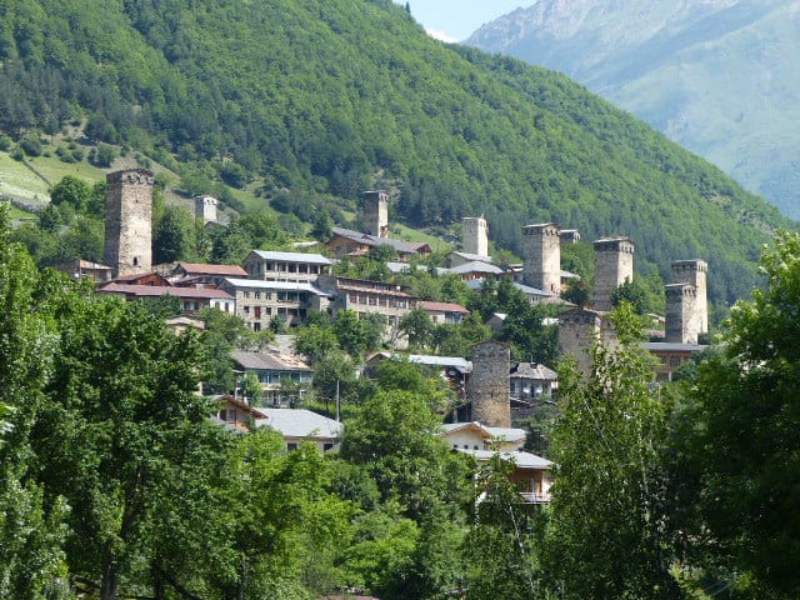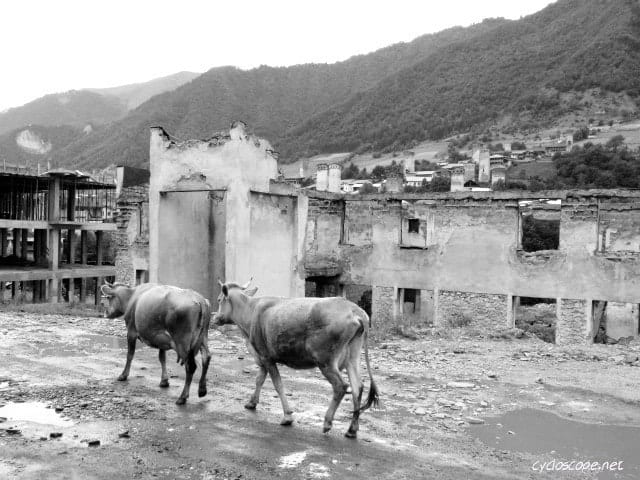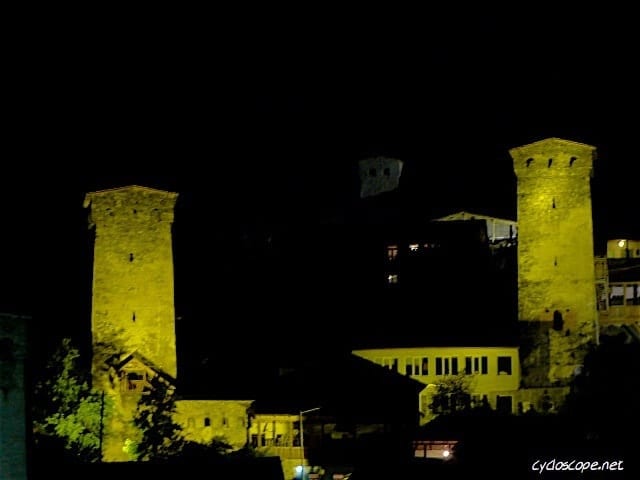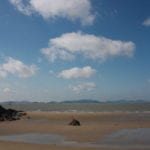Last Updated on 23 January 2025 by Cycloscope

Explore Svaneti’s culture, stunning landscapes, iconic towers, and local hospitality on an adventurous journey from Kaishi to Mestia.
After exploring Kaishi, where the Khudoni Hydropower project should flood, we head to the ancient village of Mestia, 1500 msl. Mestia is home to the iconic Svan defensive towers (lushnukor) and is the historical center of the Svan culture.
A place that claims to have never been conquered or defeated by any enemy, even Genghis Khan, they say, gave up on his attempt to conquer the capital of Svaneti. Plus, Mestia is the base for some of the best treks in the Caucasus.
Khaishi – Mestia
Stuck in a loop of indecision. Mestia. Ride the bike or take a marshrutka (minibus)? It’s hot, very hot. Seventy kilometers of violent ascent, with the ever-present danger of landslides. Elena is not in her best shape, with women’s issues.
We will take a marshrutka, giving the bikes a rest after the last stressful days in the company of the kids.
Getting to Mestia from Kaishi

We go to the “center” of Khaishi and wait, under the doubtful gaze of the lady of the “bar”. An hour passes in which we try to stop anything that has the appearance of a van, but we are ignored.
After two hours a gray van approaches, carrying flour. A man came out and started speaking with some local women, including the bartender. After a while we understand that the lady is trying to intercede for us, the man is directed to Latali, 9 km from Mestia, and eventually, he agrees to give us a ride.
Finally, we leave, at 3:30 pm, now we understand that this will be a long journey, the man is carrying 4 tons of flour, about four times the stated maximum load of the van. The average is 30 km/h, with a peak of 5 km/h.
It seems to be on a bicycle. In addition, whenever the climb becomes steeper (almost always) the man opens the hot air valve to the maximum to vent the heat out from the engine, which could seriously melt (in fact, we see several vehicles stranded along the way). We roast. Landslides are everywhere.
At about 6:00 pm we arrive at Latali, the end of the ride. We greet our driver and offer some money, which he refuses, and we set off on foot to Mestia. Latali is a beautiful village, dotted by classic defensive towers. It exudes an ancient atmosphere. Even if not cycling, people look at us like aliens anyway.
The lushnukor towers are the traditional houses of the Svan people. On the ground floor, livestock is stored, while the family lives on the upper floor, reachable only by a wooden ladder. The ladder can be withdrawn inside the house in case of undesired visitors, making thus the dwelling very difficult to attack.
Walking from Latali to Mestia
The scenery is breathtaking. To the south, east, front of us… All around the steep ridges of verdant forests, striped by clear streams that descend vertically, almost like waterfalls, the highest peaks are covered with snow, even here the cows are everywhere.
We walk about five kilometers in a sort of mystical exaltation, but the sunset is near, we try to hitchhike. We easily succeeded in our aim, two tourists from the capital with a rental car finally led us to Mestia.
How sublime must this view have been, only a few decades ago! But tourism has not affected but superficially the charm of this ancestral settlement, the towers are dozens, dominating the village while highlighting its ancient fame of being invincible.
The guest houses are everywhere but we have a tent, we are looking for a place suitable for free camping. We cross the horrible bridge over the river and we see a little sign of a campsite.
A man greets us in the company of a little boy, who does not speak a word of English but it is irresistible. His name is Gocha Paliani. The camp costs 15 lari, about 6 euros per night. There is a real WC. Enough to convince us.
We are the only guests, the camp is a meadow near the woodshed. In the garden, there is the tomb of his father. Here, too, cows, three of them. Take two beers and spend the evening with Gocha, trying our best to communicate. He lives with his sister and 94-year-old mother. We can not figure out who the boy is.
The view is gorgeous, the towers are lit at night. Then it rains, we watch Argentina vs Nigeria.
Mestia
The Museum of Svan Culture plus some wine
We wake up rested. Gocha offers us a yogurt that tastes like a cow. We go down to the center and ask the price of a round-trip ride to Ushguli, the road is not doable by Mashrutka, only 4×4 taxis, they ask us 200 lari each, and we give up immediately without any bargaining, way out of our budget.
So we go to the museum of Svani Culture, a branch of the national ethnographic museum. Small but beautiful, one of the best museum setups I’ve ever seen. The lights are perfect.
There is a collection of icons of superb workmanship from the ninth to the nineteenth century. St. George skewering Diocleziano (in dragon form or in the form of Diocletian) is the absolute protagonist.
And the weapons: rifles of a meter and a half, knives, and swords that are pieces of art. Musical instruments, clothing, jewelry, and much more. A processional cross made of brass, with figures of saints in bas-relief, keeps me glued to the window for at least ten minutes.
We go out almost stunned and Mestia appears in a different light, almost as if a time machine not yet set up shows us the Mestia of older times, superimposed on that of today, both as blurry as in a mirage. We wander in the sun between the towers. But, like a stun, the best is to come.
Back at camp, we find Gocha, waiting for us with 5 liters of wine… and we go. A toast to the health of our fathers, our mothers, ancestors underground, life, the universe, and everything. The soundtrack is Legend of Bob Marley, Georgian polyphony, and Flamenco, the only three tapes in Gocha’s collection.
We finish the 5 liters in a couple of hours… me, Elena, and Gocha. We go to bed in the sunlight.
Traditional Svan Music

Stunning, in fact. Upon waking, my head is like a balloon. We want to leave but Gocha tells us that tomorrow he must go to Tbilisi by car and he can give us a ride, perfect.
So given that, we will spend another day here. We go for a walk in the neighboring town, another village full of towers, but no tourists, so more authentic.
But on our return, at about 2:00 pm, Gocha Paliani is there waiting for us, with two friends and a bottle of Vodka. We can’t do it, we make a toast for kindness, but as always, the situation degenerates. We move into the house, and another friend of Gocha comes.
It also comes with another bottle of a strange Vodka flavored with chili peppers. Heavy shit. They begin to sing, one is particularly good. Gocha tries to sneak into the polyphony but he can’t do it! We rapidly get drunk, singing too, and even dancing. Even today we go to bed in the daylight!
Escape from Mestia
We wake up more dazed than ever! Gocha is still asleep, at 8 o’clock we should leave together for Tbilisi but one hour goes and nothing moves, no sign of life. We get a coffee, we go find some cookies at the market, and we get back to the Paliani campsite, but still nothing! We sit outside to wait.
At some point, I think around 11, there appears a Gocha Paliani that seems to come directly from the afterlife. He is holding 5 lari and just says “Magazin, Panta Panta”. So, back to the market to buy him the Fanta. When we get back he’s still in bed, I know that you will not go to Tbilisi today man.
Tourists come to ask for the camping, we wake up Gocha, he comes out like a bare-breasted zombie and “explains” that that is the camping and ie and ie and ie (he talks like that), and goes back to bed. In the end, we decide to leave money on the table, along with a note and we leave.

Just in time to cross the bridge and meet the friend of Gocha who is emerging from the market, and what can be bought in the market at noon? Cookies and whiskey!
It is in a plastic bottle and first I think he’s kidding us, he wants to force us to go and see the house he’s building. He also wants us to drink with him. Not again! We are able to “get away” in a reasonable time. He gives us the cookies and keeps the whiskey.
It is 1:00 pm and finally, we reach the square where, however, there is not even a marshrutka, only cars asking for lots of money. The tourist office girl tells us that the bus for Khaishi only departs in the morning. It seems strange because we have seen a lot while getting to Mestia. Meanwhile, it begins to rain.
We wait for the rain to slow down, and we move towards the “suburbs” of the village in search of a lift.
We meet a parked marshrutka, it goes to Tbilisi, it will lead us to Kaishi for 10 lari (4 euros), we are the only passengers and we sit in the front with the driver, a devout Orthodox who makes the sign of the cross three times each time he passes next to a statue of the Virgin, a cross, a church, a cemetery, well, basically is a non-stop.
We would prefer him to keep his hands on the steering wheel. However, we adapt and we make the sign of the cross, too, more as an exorcism for landslides. Only halfway he smiles and we see that he has full golden teeth! All of them! That is a really expensive mouth, we guess.
We arrived in Khaishi, our bikes were closed in the bathroom, away from children harassing us. They ask us if we want to eat there, but we prefer to leave. We are quite in a coma. We eat a khachapuri along the way and we stop to sleep shortly after by our friend Jesus.
Follow Us


